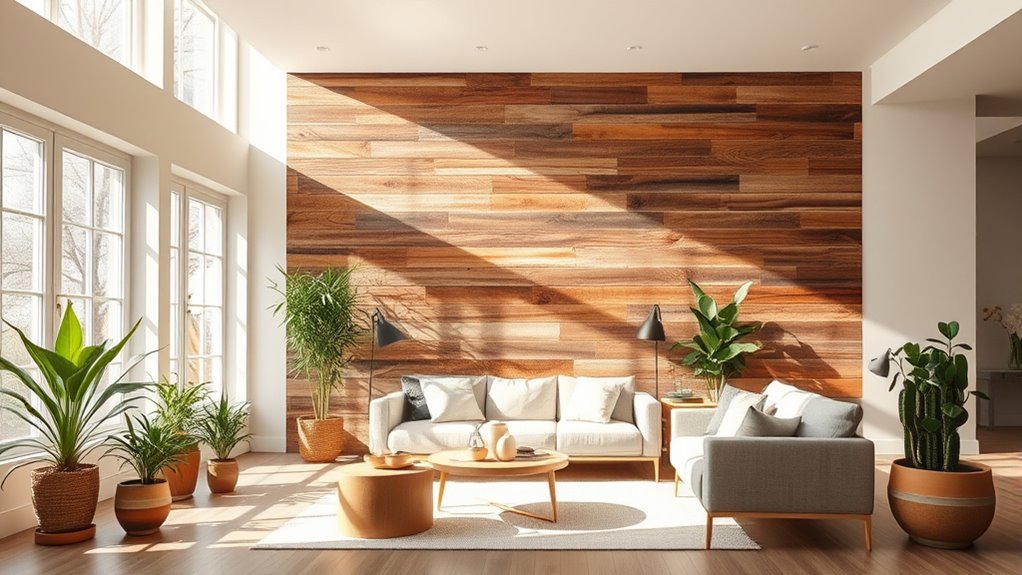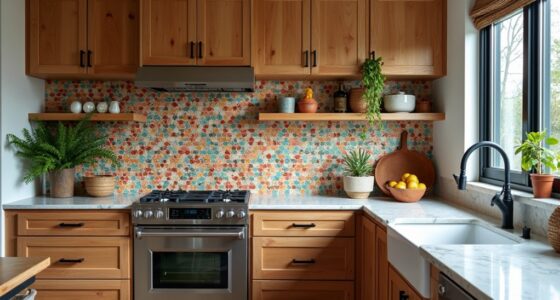Sustainable home improvement using reclaimed wood and eco-friendly paints helps you reduce environmental impact while making your space beautiful. Reclaimed wood adds warmth, durability, and unique character, while eco-friendly paints improve indoor air quality and safety. Choosing sustainable materials for each area of your home supports energy efficiency and reduces waste. If you want to discover creative ideas and practical tips for incorporating these eco-friendly options seamlessly into your project, you’re in the right place.
Key Takeaways
- Using reclaimed wood reduces deforestation, waste, and energy consumption, promoting a circular and eco-friendly material lifecycle.
- Selecting low-VOC or zero-VOC eco-friendly paints improves indoor air quality and supports healthier living environments.
- Proper application and maintenance of reclaimed wood and eco paints extend their durability and environmental benefits.
- Combining reclaimed wood and eco paints enhances aesthetic appeal while minimizing environmental impact in interior spaces.
- Incorporating sustainable materials aligns with green building principles, contributing to eco-conscious home improvement practices.
Benefits of Using Reclaimed Wood in Home Projects
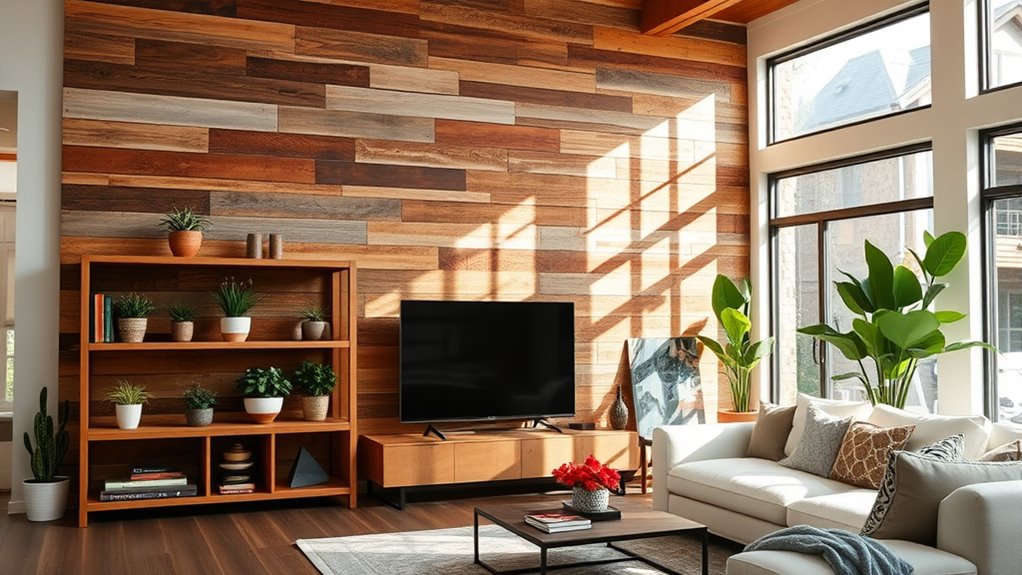
Using reclaimed wood in your home projects offers several environmental benefits. It’s a sustainable material that helps reduce deforestation by repurposing salvaged timber, decreasing the demand for new lumber. This minimizes waste sent to landfills and lessens the environmental impact of manufacturing fresh materials. Reclaimed wood often features unique character, like aged patina and varied grain patterns, adding aesthetic appeal to your home improvement projects. By choosing natural materials like reclaimed wood, you support a circular economy that emphasizes reuse and recycling. It requires less energy to process compared to new wood, making it an eco-friendly choice for building a sustainable home. Additionally, incorporating self-watering plant pots can further enhance your eco-friendly practices by promoting efficient water use in your indoor gardening. Embracing these sustainable choices not only enhances your space but also encourages environmentally responsible practices in your home improvement efforts.
How to Incorporate Eco-Friendly Paints for a Healthier Home
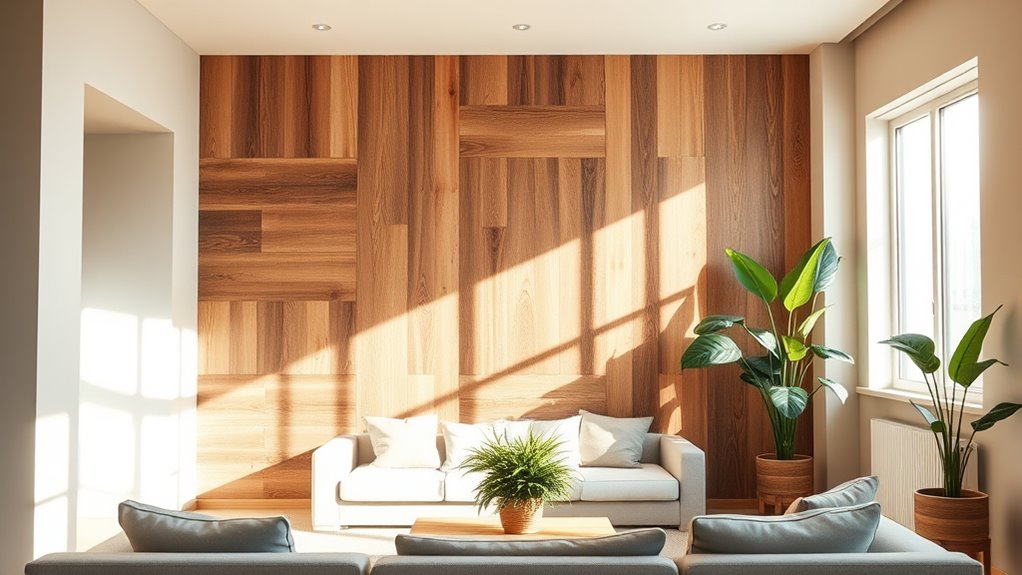
When selecting eco-friendly paints, opt for low-VOC or zero-VOC options to improve indoor air quality. Proper application techniques, like surface preparation and correct disposal, guarantee you get the most health benefits. Using water-based paints also makes cleanup easier and reduces chemical emissions in your home. Embracing sustainable practices in your painting project can also foster a creative mindset, encouraging innovative solutions for eco-friendly home improvements.
Choosing Low-VOC Options
Choosing low-VOC paints is a smart step toward creating a healthier home environment, especially since these paints emit fewer harmful fumes than traditional options. By selecting low-VOC paints, you improve indoor air quality and support sustainable choices. Look for certifications like Green Seal or Greenguard to ensure the paint meets strict eco-friendly standards. Proper surface preparation and priming enhance adhesion and extend paint durability, maximizing environmental benefits. Incorporating natural finishes alongside low-VOC paints further promotes a healthier living environment. These choices not only reduce indoor pollutants but also contribute to a more eco-friendly home. Additionally, understanding the sustainability in paint production can help you make more informed choices that benefit both your health and the environment. Choosing paints with eco-friendly ingredients reduces exposure to toxic chemicals and supports environmentally responsible manufacturing practices. Opting for low-VOC paints aligns with your goal of sustainable living while safeguarding your family’s health and well-being. Incorporating self-understanding about your personal preferences can guide you toward selecting the most suitable eco-friendly options for your home. Exploring innovative eco-friendly paint technologies can further enhance your efforts to create a greener living space. Moreover, being aware of the role of consumer education can empower you to make better environmentally conscious decisions when choosing paints.
Proper Application Techniques
Proper application techniques are key to maximizing the benefits of eco-friendly paints in your home. Start with thorough surface preparation, including cleaning and priming, to guarantee the paint adheres well and results in a durable finish. Use quality brushes or rollers to achieve even coverage and minimize splatter, which helps reduce waste. Follow the manufacturer’s instructions for proper drying times and application conditions, such as temperature and humidity, to prevent defects and extend the paint’s lifespan. Choosing eco-friendly paints with low or zero VOC levels improves indoor air quality during and after application. Additionally, understanding essential oil properties can inspire natural solutions for healthier indoor environments. Proper disposal of leftover paints and cleaning tools responsibly, adhering to local environmental compliance standards, is also essential. These steps ensure you get a professional look while supporting sustainable home improvement practices, especially when selecting eco-friendly paints that are better for your health and the environment. Incorporating advanced automation techniques can also help in monitoring and controlling indoor air quality, further promoting a healthier home. Recognizing the importance of trust issues in home projects can help you establish confidence and ensure the longevity of your improvements.
Choosing Sustainable Materials for Different Areas of Your House
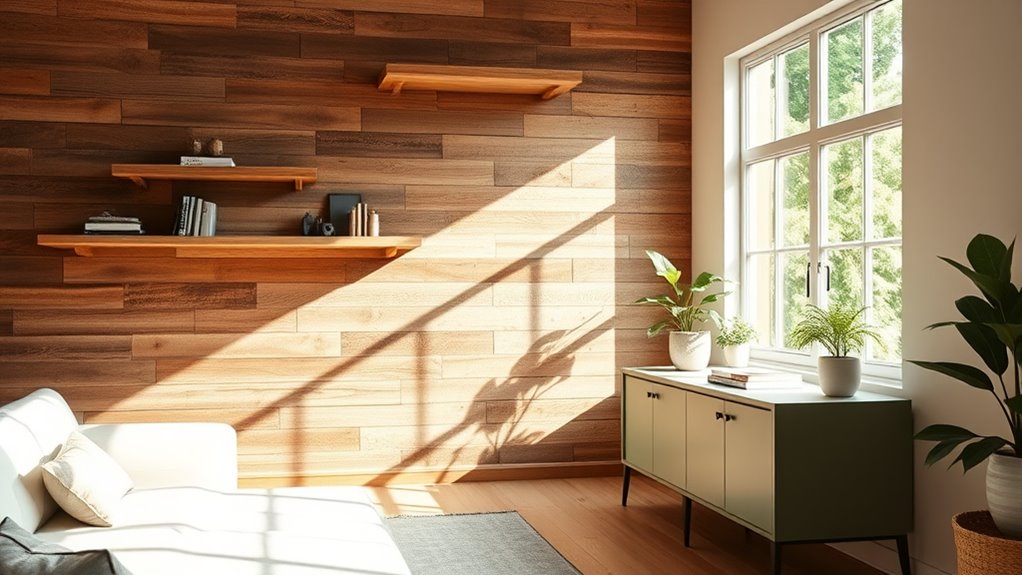
Selecting sustainable materials for different areas of your home allows you to optimize both environmental benefits and aesthetic appeal. Reclaimed wood can add warmth and durability to living rooms and dining areas while reducing deforestation by up to 90%. Incorporating best woods for farmhouse tables like oak or walnut can enhance your furniture’s longevity and style. Additionally, eco-friendly paints with low or zero VOCs help maintain indoor air quality, making bedrooms and children’s spaces safer. Using renewable and environmentally friendly materials also boosts energy efficiency and decreases your carbon footprint. Growing your own chia seeds can be a simple way to incorporate fresh, nutritious ingredients into your diet while promoting sustainable practices. Choosing eco-friendly paints that are free from harmful chemicals further supports healthier indoor environments. Utilizing organic and natural juices in your home recipes further supports eco-conscious living by reducing reliance on processed beverages.
Creative Ways to Repurpose Reclaimed Wood in Interior Design
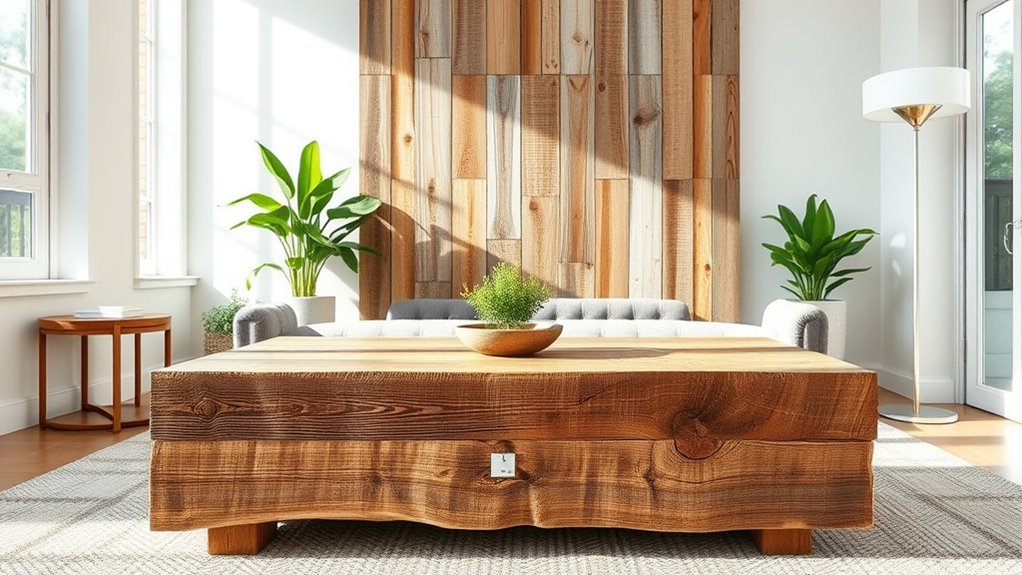
Reclaimed wood offers a versatile way to add character and sustainability to your space. You can create striking feature walls or craft custom furniture pieces that reflect your style. Exploring these options helps you design a unique, eco-friendly home. Additionally, incorporating reclaimed wood can contribute to environmental support by reducing waste and minimizing the demand for new resources. Being aware of the IRA investment strategy can also help optimize your financial resources for sustainable home projects. Utilizing eco-friendly paints not only enhances aesthetics but also supports user privacy and safety by reducing exposure to harmful chemicals. Incorporating portable camping gear like lightweight tents and solar panels can further enhance your eco-conscious lifestyle beyond the home. When working with reclaimed wood, understanding how to change gears on a gravel bike can inspire you to approach your DIY projects with patience and precision, ensuring durability and safety.
Unique Wall Accents
Have you considered how reclaimed wood can transform your interior walls into striking focal points? By repurposing reclaimed wood into wall accents, you add natural character and texture to your space, highlighting craftsmanship and sustainable design. You can create feature walls with panels, mosaic tiles, or contrasting stained slats that showcase unique grain patterns, knots, and imperfections. These textured finishes not only elevate your decor but also promote eco-conscious choices by reducing waste and deforestation. Incorporate reclaimed wood with eco-friendly paints for a seamless, sustainable look. Some creative ideas include framing artwork, installing headboards, or forming geometric patterns. These approaches make your home more eco-friendly while adding visual interest and warmth to your interiors. Additionally, understanding the properties of reclaimed wood, such as its durability and unique aging process, helps in selecting the best pieces for your project.
Repurposed Furniture Pieces
Transforming reclaimed wood into custom furniture pieces offers a stylish way to enhance your interior while supporting sustainability. By using reclaimed wood, you create unique furniture pieces like coffee tables, headboards, and shelving that add rustic charm. Upcycling repurposed materials reduces the demand for new timber, conserving forests and lowering environmental impact—key goals of green building and environmentally conscious living. Techniques such as sanding, sealing, and finishing ensure your furniture is durable and polished. Incorporating reclaimed wood furniture not only boosts aesthetic appeal but also promotes sustainable living by extending the material’s lifecycle. Many artisans and brands now offer handcrafted reclaimed wood furniture, providing eco-friendly options that combine style with responsibility. Additionally, understanding regulatory compliance helps ensure your projects meet environmental standards and legal requirements. Being aware of cost management strategies can help you stay within your budget while pursuing eco-friendly upgrades. Recognizing the importance of certifications and standards can further enhance the credibility and environmental impact of your sustainable home projects. This approach makes your home improvement efforts more eco-conscious and aligned with green building principles.
Selecting the Right Eco-Friendly Paints for Your Renovation
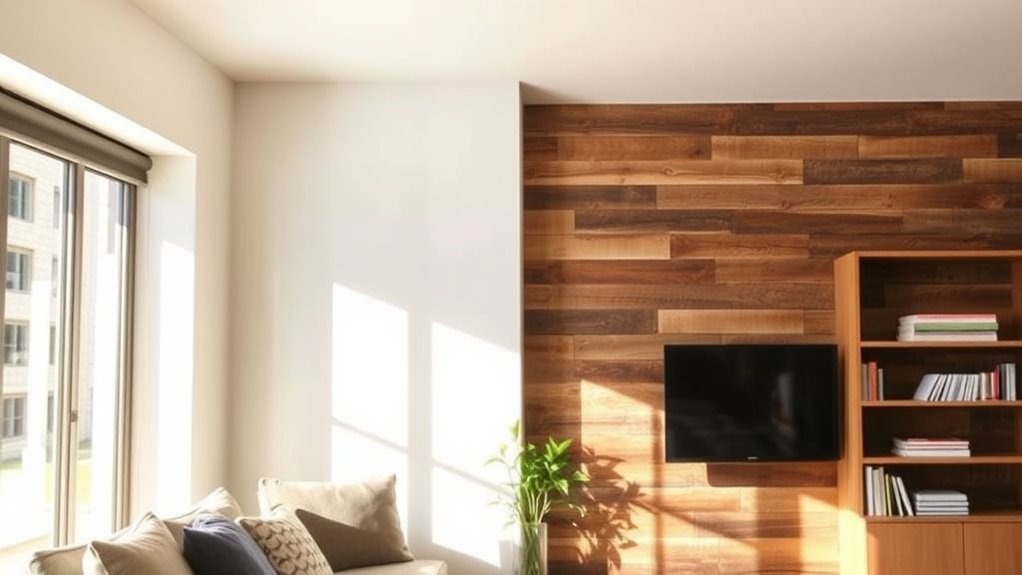
Choosing the right eco-friendly paints for your renovation involves more than picking a color; it requires careful consideration of their environmental and health benefits. Look for eco-friendly paints with low or zero VOCs to minimize toxic emissions and improve indoor air quality. Certifications like Green Seal, Greenguard, or EcoLogo guarantee the paint meets strict environmental standards. Water-based paints and plant-based paints are excellent choices because they use renewable ingredients and are easier to clean up. Additionally, consider paint durability and finish to meet your project’s aesthetic and functional needs. Proper surface prep and disposal are also vital to maximize environmental benefits.
Choose eco-friendly, low or zero VOC paints with certified standards for a healthier, sustainable renovation.
- Verify green certification and eco-labels to guarantee compliance
- Choose water-based or plant-based options for sustainability
- Assess durability to match your renovation’s demands
Environmental and Aesthetic Advantages of Sustainable Building Materials
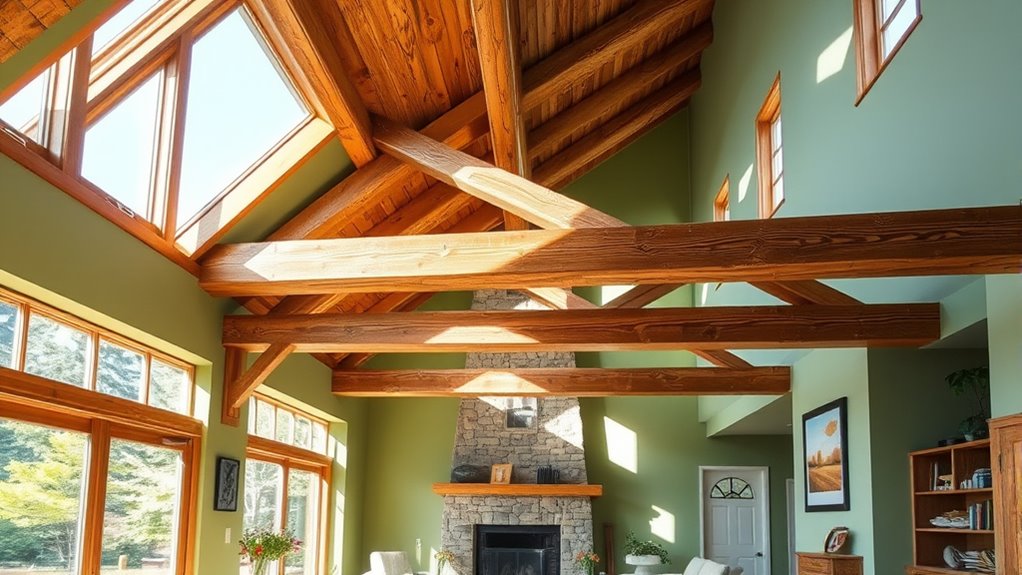
Sustainable building materials offer both environmental benefits and aesthetic appeal, making them an excellent choice for eco-conscious renovations. Reclaimed wood reduces deforestation and minimizes construction waste, giving your space a unique, aged charm with natural knots and grain patterns. Eco-friendly paints with low or zero VOCs improve indoor air quality by decreasing toxic fumes and chemical runoff, supporting healthier living environments. Using these sustainable materials aligns with green building principles and promotes an environmentally responsible approach to interior design. Combining reclaimed wood and eco-friendly paints creates a visually stunning, eco-conscious space that highlights both natural beauty and sustainability. By choosing these environmentally responsible building materials, you enhance your home’s aesthetic while reducing your environmental footprint.
Tips for Maintaining and Caring for Reclaimed Wood and Eco-Friendly Paints
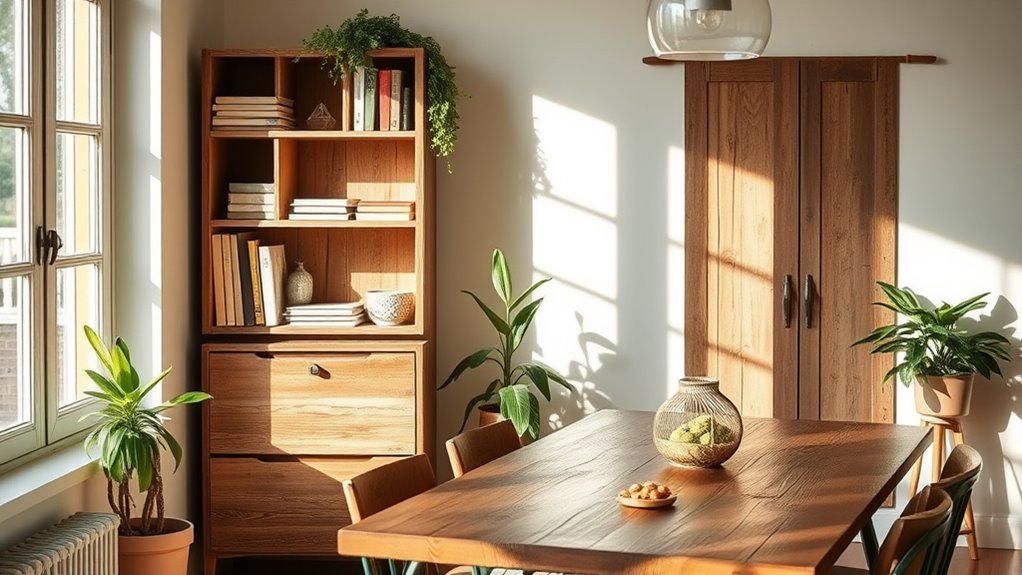
Proper maintenance is essential to keep reclaimed wood and eco-friendly paints looking their best and performing well over time. To maintain their natural beauty and durability, regularly clean reclaimed wood with a damp cloth to prevent dust buildup, using eco-friendly cleaning products to protect the finish. Protect surfaces from excessive moisture and direct sunlight to avoid warping, fading, or cracking. Reapplying eco-friendly sealants or finishes periodically helps preserve the wood’s integrity and enhances sustainability benefits. For eco-friendly paints, touch up with matching colors after surface preparation to ensure a seamless, durable finish. Proper surface preparation and moisture protection are key to long-lasting results.
- Use a sealer to boost durability and moisture resistance
- Ensure surface preparation before touch-ups or recoating
- Reapply eco-friendly sealants regularly for ongoing protection
Frequently Asked Questions
What Is the Most Eco-Friendly Paint for a House?
You’re wondering about the most eco-friendly house paint. Opt for low-VOC or zero-VOC options, which release fewer harmful chemicals. Water-based paints made from natural ingredients, like plant-based pigments, are also excellent choices. Look for certifications such as Green Seal or Greenguard to confirm the paint meets strict environmental standards. Natural mineral-based paints like clay or lime are non-toxic and eco-friendly, making them ideal for a sustainable home.
Is Reclaimed Wood Eco-Friendly?
You wonder if reclaimed wood is eco-friendly, and the answer is yes. By repurposing existing timber, you reduce demand for new logging, helping prevent deforestation. It also cuts down waste, giving old wood a new life, and requires less energy to produce. Plus, sourcing locally minimizes transportation emissions. So, choosing reclaimed wood supports sustainable building, lowers your carbon footprint, and adds unique character to your home.
Is Wood Paint Environmentally Friendly?
You might wonder if wood paint is eco-friendly. Many options use low or zero VOCs, which cut down on harmful emissions during application. Natural, plant-based paints further reduce ecological impact by using biodegradable ingredients. Look for certifications like Green Seal. Choosing these paints not only helps the environment but also improves your indoor air quality, making your home healthier and more sustainable.
What Are the Disadvantages of Eco-Friendly Paint?
Perceiving paint’s problems, you’ll find eco-friendly options often come with a higher cost and limited choices, posing practical problems. Longer drying times can delay your project, while less durability may mean more frequent touch-ups. Availability issues and inconsistent quality can complicate sourcing. Though eco paints promise environmental benefits, they sometimes present practical pitfalls—price, patience, and potential performance problems—that you should weigh carefully before choosing your coating.
Conclusion
By choosing reclaimed wood and eco-friendly paints, you’re not just renovating—you’re giving new life to materials that might have been discarded. Imagine turning a worn-out pallet into a stunning coffee table, transforming waste into beauty. Studies show sustainable choices can reduce your home’s carbon footprint by up to 30%. Every small step you take toward eco-friendly improvements is like planting a seed for a healthier planet—your home becomes a sanctuary for both you and the environment.
